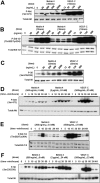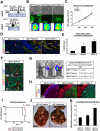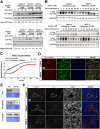Netrin-4 induces lymphangiogenesis in vivo
- PMID: 20407033
- PMCID: PMC2902137
- DOI: 10.1182/blood-2009-11-252338
Netrin-4 induces lymphangiogenesis in vivo
Abstract
Netrin-4, a laminin-related secreted protein is an axon guidance cue recently shown essential outside of the nervous system, regulating mammary and lung morphogenesis as well as blood vascular development. Here, we show that Netrin-4, at physiologic doses, induces proliferation, migration, adhesion, tube formation and survival of human lymphatic endothelial cells in vitro comparable to well-characterized lymphangiogenic factors fibroblast growth factor-2 (FGF-2), hepatocyte growth factor (HGF), vascular endothelial growth factor-A (VEGF-A), and vascular endothelial growth factor-C (VEGF-C). Netrin-4 stimulates phosphorylation of intracellular signaling components Akt, Erk and S6, and their specific inhibition antagonizes Netrin-4-induced proliferation. Although Netrin receptors Unc5B and neogenin, are expressed by human lymphatic endothelial cells, suppression of either or both does not suppress Netrin-4-promoted in vitro effects. In vivo, Netrin-4 induces growth of lymphatic and blood vessels in the skin of transgenic mice and in breast tumors. Its overexpression in human and mouse mammary carcinoma cancer cells leads to enhanced metastasis. Finally, Netrin-4 stimulates in vitro and in vivo lymphatic permeability by activating small GTPases and Src family kinases/FAK, and down-regulating tight junction proteins. Together, these data provide evidence that Netrin-4 is a lymphangiogenic factor contributing to tumor dissemination and represents a potential target to inhibit metastasis formation.
Figures





Similar articles
-
Netrin-4 inhibits angiogenesis via binding to neogenin and recruitment of Unc5B.Proc Natl Acad Sci U S A. 2008 Aug 26;105(34):12491-6. doi: 10.1073/pnas.0804008105. Epub 2008 Aug 21. Proc Natl Acad Sci U S A. 2008. PMID: 18719102 Free PMC article.
-
Netrin-4 activates endothelial integrin {alpha}6{beta}1.Circ Res. 2011 Sep 16;109(7):770-4. doi: 10.1161/CIRCRESAHA.111.247239. Epub 2011 Jul 28. Circ Res. 2011. PMID: 21799154 Free PMC article.
-
Blocking Fibroblast Growth Factor receptor signaling inhibits tumor growth, lymphangiogenesis, and metastasis.PLoS One. 2012;7(6):e39540. doi: 10.1371/journal.pone.0039540. Epub 2012 Jun 25. PLoS One. 2012. PMID: 22761819 Free PMC article.
-
Netrin-integrin signaling in epithelial morphogenesis, axon guidance and vascular patterning.Cell Cycle. 2005 Mar;4(3):e131-5. Epub 2005 Mar 18. Cell Cycle. 2005. PMID: 15725728 Review.
-
Netrin-4: Focus on Its Role in Axon Guidance, Tissue Stability, Angiogenesis and Tumors.Cell Mol Neurobiol. 2023 Jul;43(5):1663-1683. doi: 10.1007/s10571-022-01279-4. Epub 2022 Nov 9. Cell Mol Neurobiol. 2023. PMID: 36350538 Free PMC article. Review.
Cited by
-
Netrin-4 promotes glioblastoma cell proliferation through integrin β4 signaling.Neoplasia. 2012 Mar;14(3):219-27. doi: 10.1593/neo.111396. Neoplasia. 2012. PMID: 22496621 Free PMC article.
-
Lymphangiogenesis Guidance Mechanisms and Therapeutic Implications in Pathological States of the Cornea.Cells. 2023 Jan 14;12(2):319. doi: 10.3390/cells12020319. Cells. 2023. PMID: 36672254 Free PMC article. Review.
-
Crosstalk in Skin: Loss of Desmoglein 1 in Keratinocytes Inhibits BRAFV600E-Induced Cellular Senescence in Human Melanocytes.J Invest Dermatol. 2025 Jul;145(7):1740-1752.e4. doi: 10.1016/j.jid.2024.10.608. Epub 2024 Nov 23. J Invest Dermatol. 2025. PMID: 39581457
-
Netrin signaling mediates survival of dormant epithelial ovarian cancer cells.Elife. 2024 Jul 18;12:RP91766. doi: 10.7554/eLife.91766. Elife. 2024. PMID: 39023520 Free PMC article.
-
Novel roles for Slits and netrins: axon guidance cues as anticancer targets?Nat Rev Cancer. 2011 Mar;11(3):188-97. doi: 10.1038/nrc3005. Epub 2011 Feb 17. Nat Rev Cancer. 2011. PMID: 21326323 Review.
References
-
- Sleeman JP, Thiele W. Tumor metastasis and the lymphatic vasculature. Int J Cancer. 2009 Jun 30; - PubMed
-
- Conway EM, Collen D, Carmeliet P. Molecular mechanisms of blood vessel growth. Cardiovasc Res. 2001;49(3):507–521. - PubMed
-
- Cirulli V, Yebra M. Netrins: beyond the brain. Nat Rev Mol Cell Biol. 2007;8(4):296–306. - PubMed
Publication types
MeSH terms
Substances
Grants and funding
LinkOut - more resources
Full Text Sources
Molecular Biology Databases
Miscellaneous

